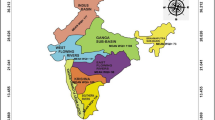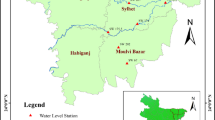Abstract
Frequent and accurate estimation of suspended sediment concentration (SSC) in surface waters and hydraulic schemes is of prime importance for proper design, operation and management of many hydraulic projects. in the present study, a long short-term memory (LSTM) was considered for predicting daily suspended sediment concentration in a river. The LSTM extends recurrent neural network with memory cells, instead of recurrent units, to store and output information, easing the learning of temporal relationships on long time scales. To build the model, daily observed time series of river discharge (Q) and SSC in the Schuylkill River in the United States were used. The results of the proposed model were evaluated and compared with the feedforward neural network and the adaptive neuro fuzzy inference system models which were trained using three different learning algorithms and widely used in the literature for prediction of daily SSC. The comparison of prediction accuracy of the models demonstrated that the LSTM model could satisfactory predict SSC time series, and adequately estimate cumulative suspended sediment load (SSL).
Similar content being viewed by others
References
Salas JD, Delleur JW, Yevjevich V, Lane WL (1980) Applied modeling of hydrologic time series. Water Resources Publication, Littleton
ASCE Task Committee on Application of Artificial Neural Networks in Hydrology (2000) Artificial neural networks in hydrology. I: Preliminary concepts, J Hydrol Eng 5(2):115–123
Jain SK (2001) Development of integrated sediment rating curves using ANNs. J Hydraul Eng 127(1):30–37
Nagy HM, Watanabe K, Hirano M (2002) Prediction of sediment load concentration in rivers using artificial neural network model. J Hydraul Eng 128(6):588–595
Agarwal A, Singh RD, Mishra SK, Bhunya PK (2005) ANN-based sediment yield models for Vamsadhara river basin (India). Water SA 31(1):85–100
Cigizoglu HK, Alp M (2006) Generalized regression neural network in modelling river sediment yield. Adv Eng Softw 37(2):63–68
Bhattacharya B, Price RK, Solomatine DP (2005) Data-driven modelling in the context of sediment transport. Phys Chem Earth 30(4–5):297–302
Raghuwanshi NS, Singh R, Reddy LS (2006) Runoff and sediment yield modeling using artificial neural networks: upper Siwane River, India. J Hydrol Eng 11(1):71–79
Tayfur G, Ozdemir S, Singh VP (2003) Fuzzy logic algorithm for runoff-induced sediment transport from bare soil surfaces. Adv Water Resour 26(12):1249–1256
Lohani AK, Goel NK, Bhatia KS (2007) Deriving stage–discharge–sediment concentration relationships using fuzzy logic. Hydrol Sci J 52(4):793–807
Rajaee T (2011) Wavelet and ANN combination model for prediction of daily suspended sediment load in rivers. Sci Total Environ 409(15):2917–2928
Kaveh K, Bui MD, Rutschmann P (2017) A comparative study of three different learning algorithms applied to ANFIS for predicting daily suspended sediment concentration. Int J Sedim Res 32(3):340–350
Anh DT, Van SP, Dang TD, Hoang LP (2019) Downscaling rainfall using deep learning long short-term memory and feedforward neural network. Int J Climatol 39(10):4170–4188. https://doi.org/10.1002/joc.6066
Duong TA, Bui MD, Rutschmann P (2018) Long Short Term Memory for monthly rainfall prediction in Camau, Vietnam
Rajaee T, Mirbagheri SA, Zounemat-Kermani M, Nourani V (2009) Daily suspended sediment concentration simulation using ANN and neuro-fuzzy models. Sci Total Environ 407(17):4916–4927
Kisi Ö (2004) Multi-layer perceptrons with Levenberg-Marquardt training algorithm for suspended sediment concentration prediction and estimation/Prévision et estimation de la concentration en matières en suspension avec des perceptrons multi-couches et l’algorithme d’apprentissage de Levenberg-Marquardt. Hydrol Sci J. https://doi.org/10.1623/hysj.49.6.1025.55720
Haykin S (1999) Neural networks: a comprehensive foundation. Prentice-Hall, Englewood Cliffs
Bhattacharya B, Price RK, Solomatine DP (2007) Machine learning approach to modeling sediment transport. J Hydraul Eng 133(4):440–450
Shahin MA, Maier HR, Jaksa MB (2002) Predicting settlement of shallow foundations using neural networks. J Geotech Geoenviron Eng ASCE. 128(9):785–793
Jang J-SR (1996) ANFIS: adaptive-network-based fuzzy inference system. IEEE Trans Syst Man Cybern 23(3):665–685
Sayed T, Tavakolie A, Razavi A (2003) Comparison of adaptive network based fuzzy inference systems and B-spline neuro-fuzzy mode choice models. J Comput Civ Eng 17(2):123–130
Jang J-SR, Sun C-T (1995) Neuro-fuzzy modeling and control. Proc IEEE 83(3):378–406
Hochreiter S, Schmidhuber J (1997) Long short-term memory. Neural Comput 9(8):1735–1780
Pascanu R, Mikolov T, Bengio Y (2013) On the difficulty of training recurrent neural networks. In: International conference on machine learning, pp 1310–1318
Graves A, Jaitly N (2014) Towards end-to-end speech recognition with recurrent neural networks. In: International conference on machine learning, pp 1764–1772
Coulibaly P, Anctil F, Bobee B (2000) Daily reservoir inflow forecasting using artificial neural networks with stopped training approach. J Hydrol 230(3–4):244–257
Toth E, Brath A (2007) Multistep ahead streamflow forecasting: role of calibration data in conceptual and neural network modeling. Water Resour Res. https://doi.org/10.1029/2006WR005383
Marquez M, White A, Gill R (2001) A hybrid neural network-feature-based manufacturability analysis of mould reinforced plastic parts. Proc Inst Mech Eng B J Eng Manufac 215(8):1065–1079
Hornik K, Stinchcombe M, White H (1989) Multilayer feedforward networks are universal approximators. Neural networks. 2(5):359–366
Zhang G, Patuwo BE, Hu MY (1998) Forecasting with artificial neural networks: the state of the art. Int J Forecast 14(1):35–62
Dawson CW, Wilby RL (2001) Hydrological modelling using artificial neural networks. Prog Phys Geogr 25(1):80–108
De Vos NJ, Rientjes THM (2005) Constraints of artificial neural networks for rainfall-runoff modelling: trade-offs in hydrological state representation and model evaluation. Hydrol Earth Syst Sci Dis 2(1):365–415
Schmitz JE, Zemp RJ, Mendes MJ (2006) Artificial neural networks for the solution of the phase stability problem. Fluid Phase Equilib 245(1):83–87
Wu CL, Chau KW, Li YS (2009) Methods to improve neural network performance in daily flows prediction. J Hydrol 372(1–4):80–93
Legates DR, McCabe GJ (1999) Evaluating the use of “goodness-of-fit” measures in hydrologic and hydroclimatic model validation. Water Resour Res 35(1):233–241
Diebold FX, Mariano RS (2002) Comparing predictive accuracy. J Bus Econ Stat 20(1):134–144
Chai T, Draxler RR (2014) Root mean square error (RMSE) or mean absolute error (MAE)?–Arguments against avoiding RMSE in the literature. Geosci Model Dev 7(3):1247–1250
Horowitz AJ (2008) Determining annual suspended sediment and sediment-associated trace element and nutrient fluxes. Sci Total Environ 400(1–3):315–343
Funding
This research was not funded by any foundation.
Author information
Authors and Affiliations
Contributions
KK and HK designed the study, processed and analyzed the data, developed the models, interpreted the results and wrote the paper. The study has been carried out under the supervision of MDB and PR, who contributed to the model development stage with theoretical consideration and practical guidance, assisted in the interpretations and integration of the results and helped in preparation of this paper with proof reading and corrections.
Corresponding author
Ethics declarations
Conflicts of interest
The authors declare no potential conflict of interest.
Additional information
Publisher's Note
Springer Nature remains neutral with regard to jurisdictional claims in published maps and institutional affiliations.
Rights and permissions
About this article
Cite this article
Kaveh, K., Kaveh, H., Bui, M.D. et al. Long short-term memory for predicting daily suspended sediment concentration. Engineering with Computers 37, 2013–2027 (2021). https://doi.org/10.1007/s00366-019-00921-y
Received:
Accepted:
Published:
Issue Date:
DOI: https://doi.org/10.1007/s00366-019-00921-y















